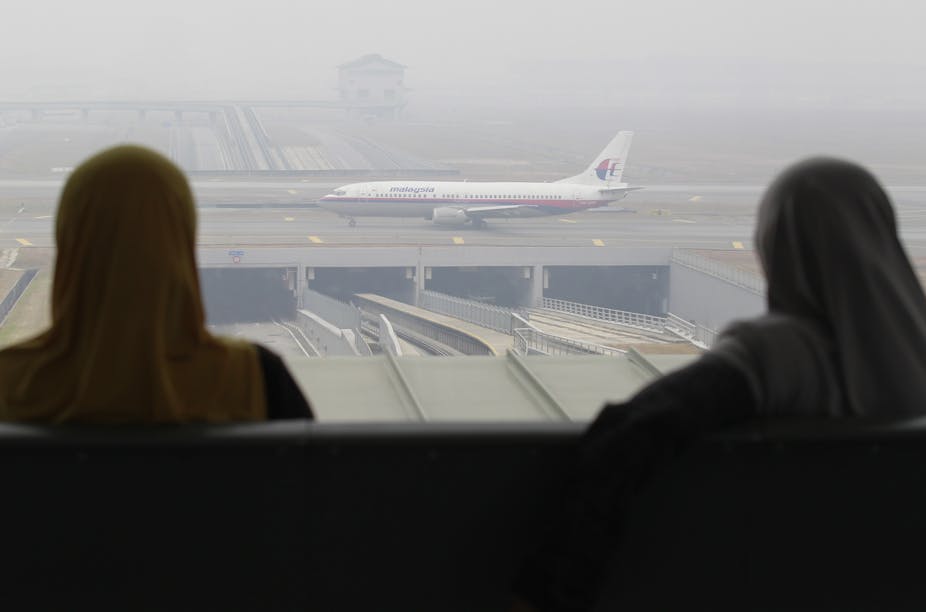As authorities rush to a remote corner of the southern Indian Ocean to identify wreckage that could be part of missing Malaysia Airlines flight MH370, speculation remains as to whether its disappearance was an act of sabotage.
This raises the question of whether more exacting surveillance of the aircraft’s location, position and communications systems could have detected it sooner as it veered off course. But if there has been foul play, we need to think about the organisational processes that might have enabled it.
Spying while they fly
At one level, arguments for greater international co-operation in satellite and air traffic control data sharing make sense in the context of a crisis such as this. Integrating GPS, primary and secondary radar and Aircraft Communications Addressing and Reporting System (ACARS) data, maybe through the cloud, would make aircraft easier to track in real time.
Geographers Martin Dodge and Rob Kitchin famously characterised commercial air travel as “code-space”: a space which is completely dependent on software which drives, among other things, GPS, radar and ACARS in order to exist at all. The radar and satellite images seen in the media of the territory in which the plane is lost are a product of that software. And as the search becomes crowdsourced, the public are relying on the same software which enables commercial flying to take place to make sense of the situation for themselves.
But all that software still needs to be operated by human beings, be they airline staff or people working in airport control rooms. In an environment which is undoubtedly hi-tech, surprisingly little managerial attention is paid to the different factors that come into play once cabin crew are in the air. We know which buttons they push and when but we don’t know much about the context in which they push them.
It’s tempting to suggest that pilots should be rigged up with biometric sensors which will detect the first signs of distress, fatigue or illness. Perhaps this would have alerted ground staff to problems on MH370. But the picture is more complicated, particularly if we want to learn from incidents and prevent them from happening again.
When the doors have been cross-checked for take-off on an aircraft, working cultures, interpersonal relationships and personalities are sealed into a tiny pressurised space. And in terms of management processes, there are potentially huge gaps between what is known about how a set of aircraft systems is operated and what is going on with the human beings as they operate them.
Airline staff are well trained and professional but even the most professional people can be affected by personality clashes or bad management. When the crew is sealed inside the plane, there are no managers watching over them, they have to govern themselves.
Biometric surveillance of air crew doesn’t address the obvious fact that, if this was pilot sabotage, it was enabled by a huge amount of tacit knowledge: the unwritten, unspoken knowledge of working practices that every human being possesses. In the MH370 case, the pilot’s tacit knowledge of aircraft tracking systems and his knowledge of how all the systems worked together were critical. Tacit knowledge is notoriously difficult to manage and is beyond the sight of surveillance technologies. And gaps in surveillance systems are where resistance or sabotage can creep in.
In Norris and Armstrong’s classic study of urban CCTV, for example, urban inhabitants played games of “cat and mouse” with camera operators, based on their knowledge of the cameras’ locations. Exacting surveillance sometimes prompts the behaviour it was installed to prevent.
In the inquiries that follow fatal industrial accidents, such as Aberfan, Bhopal or Challenger, management regimes are often made culpable. Malaysia Airlines is already under scrutiny for the way it has handled the MH370 situation, but there are bigger questions to ask than, simply, did the technology fail?
The satellites, software, aircraft, airports and crew which feature in this story are joined together by a series of business organisations which exist and collaborate to make profit. If MH370’s disappearance is down to pilot sabotage, the question of how it was allowed to happen should take this into account.
We have to ask whether organisational conditions could have prompted such an action. Could it really just be down to the activities of an individual employee in crisis? Questions need to be raised concerning support for aircrew in the demands of their job. Were they trusted? Were they treated with respect as professionals? Were they rewarded equitably? It’s easy to look to surveillance technologies for answers when a Boeing 777 disappears, but examining organisational processes closer to home may turn out to be more revealing.

